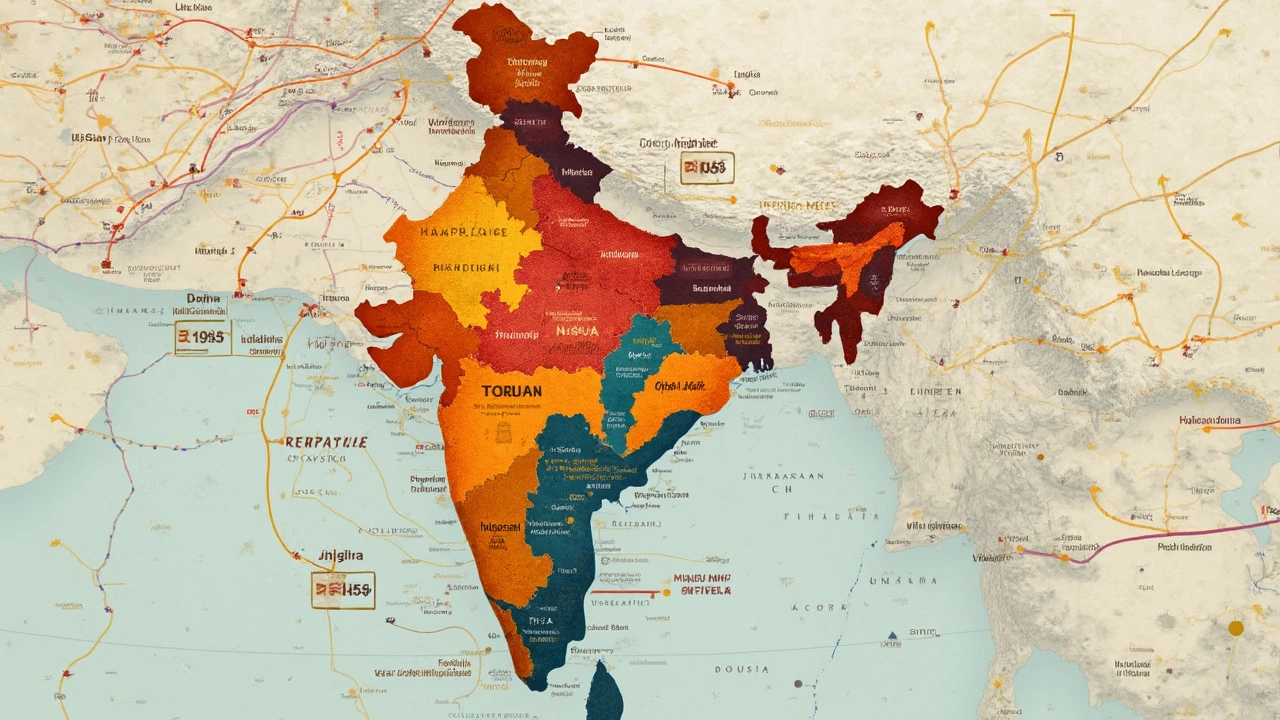So, how does India really set its minimum wage, and more importantly, what does it look like in US dollars? In 2025, navigating the minimum wage in India is a bit like solving a puzzle. It's not a one-size-fits-all situation because laws and amounts vary across states and industries, making it both fascinating and a tad confusing. Whether you're comparing wages globally or just curious, there's a lot to learn here.
Now, if we're talking numbers, imagine this: a typical minimum wage in one of India's key metropolitan areas might hover around 15,000 Indian Rupees per month. You might be doing the math in your head right now, but let’s get to the chase. Based on the exchange rates today, that would be roughly around 180 US dollars. This might sound like a stark contrast compared to wages in the West, but context is everything. India’s cost of living plays a huge role in how far that paycheck will stretch.
Since each Indian state has its own minimum wage policies, influenced by local living costs and industries, it's not just about the numbers. It’s about how these wages adapt to local conditions, providing insight into how different regions prioritize employment laws. Understanding this mosaic of wages can be tricky, but incredibly enlightening. For foreigners working here or any curious soul, comparing them against your home country's wages can be an eye-opener.
- Understanding India's Minimum Wage System
- How State Variations Affect Wages
- Converting Indian Wages to US Dollars
- Impacts of Minimum Wage Policies in India
- Practical Implications for Workers and Employers
Understanding India's Minimum Wage System
Navigating the minimum wage in India feels like diving deep into a rich tapestry of rules and regulations. It’s a place where federal and state governments each play a role, leading to a maze of numbers and rules. The first thing to grasp is that India doesn’t have a single national minimum wage like some countries do. Instead, it sets up floors through the Minimum Wages Act of 1948, and then each state decides on specifics based on local living costs and economic climates.
Every state sets its own rates, often influenced by factors like the predominant industries present and cost of living in both urban and rural areas. For instance, Maharashtra might have different slab rates compared to a state like Bihar. To make it more complicated, within a state, there will be varied minimum wages for different sectors. Yep, it’s like ordering from a menu where each dish has a unique price tag!
As of 2025, some states have even opted for more frequent updates to their minimum wage, adjusting them annually or bi-annually. This is usually done to combat inflation and make sure the wages remain relevant. However, it's important to note that these wages aren't just for the big industries; even the smallest businesses have to comply.
In practice, the rules mean that an unskilled worker in one state might earn significantly less than a skilled worker in another, due to this flexibility. Let's take a closer look using some numbers:
| State | Minimum Wage Rate (INR/month) |
|---|---|
| Maharashtra | 15,000 |
| Tamil Nadu | 13,500 |
| Bihar | 11,000 |
These differences bring to light how each region’s economic identity shapes wage laws. For anyone tracking employment law in India, or comparing wage conversion across states, it's crucial to stay updated with these variations. This system might seem a bit all over the place, but it reflects India's vast diversity and attempts to balance local needs with national objectives.
How State Variations Affect Wages
The idea that there's a single minimum wage across India? It's a bit of a myth. You see, each Indian state has its own minimum wage, and these variations are not just random. They're shaped by a whole bunch of local factors, like the cost of living, economic demands, and even the type of industries dominant in that region.
If you take Maharashtra, especially in metro cities like Mumbai, the minimum wage tends to be on the higher side compared to a place like Bihar. Why? Because the cost of living in Mumbai is through the roof. Housing, transportation, and just about everything can cost more. In contrast, states with lower living costs or less industrial development might have lower minimum wages. It’s not about one being better or worse—it’s about regional realities.
Here's a cool way to see it. Imagine this table showing how varied things can be:
| State | Industry | Minimum Monthly Wage (Rs) | Equivalent in US Dollars |
|---|---|---|---|
| Maharashtra | Manufacturing | 15,000 | ~180 |
| Bihar | Agriculture | 8,000 | ~96 |
| Tamil Nadu | IT Services | 14,000 | ~168 |
Isn't it intriguing how these numbers can tell a story? Policies also play a role here. States sometimes adjust their minimum wage based on economic conditions, like inflation or job market trends. They might want to attract more businesses or ensure workers can cope with increasing expenses.
Now, how does all this variation affect the average worker? Well, if you're working in a state with a lower minimum wage, every rupee might count more in day-to-day expenses. For employers, these differences can influence where they choose to set up shop or hire more staff. In a way, each state's approach to setting its minimum wage reflects its unique economic strategy, trying to balance growth with people's needs.

Converting Indian Wages to US Dollars
Alright, let’s break it down. If you're trying to figure out how to convert the Indian minimum wage to US dollars, you're not alone. It’s a vital calculation for anyone interested in the global wage landscape. As of 2025, the exchange rate hovers around 1 US dollar for approximately 83 Indian Rupees, but this can shift based on market dynamics.
So, let's say you're earning a minimum wage of 15,000 Indian Rupees a month in India, which is common in metro areas. To convert this into US dollars, you simply divide your salary by the exchange rate. Here’s the quick math:
- Salary in INR: 15,000
- Exchange Rate: 83 INR = 1 USD
- Salary in USD: 15,000 / 83 = approximately 180 USD
This conversion gives you a rough picture, but remember, currency rates may change daily. Keep an eye on reliable financial news sources or use currency conversion tools for the most accurate updates.
What does this mean for the Indian worker? Well, if you're earning that amount, the cost of living, which is lower in many parts of India compared to the US, makes it potentially manageable, depending on where you live.
Employers and businesses looking to hire in India also need to consider these conversions, especially if they're budgeting for salaries against their home countries' financial standards. Misjudging the forex impact could either bloat costs or shortchange the talent pool.
For those unfamiliar with international wages, comparing these figures against your local standards can be eye-opening. It highlights why multinational companies might be drawn to the Indian workforce while stressing certain challenges faced by local employees.
Impacts of Minimum Wage Policies in India
Minimum wage policies in India have a direct impact on daily life for millions of workers, and their implications stretch far beyond just paychecks. This patchwork of laws means that some workers are better off than others, depending on where they're employed. Let's break down how these policies shape the workplace and the economy.
For starters, the effectiveness of a minimum wage really hinges on the cost of living in each region. In booming cities like Mumbai or Bangalore, wages in Indian Rupees might seem decent, but the reality is they often just cover the basics due to high living costs. This creates challenges for workers trying to make ends meet. Conversely, in rural areas, the same wage might take you further.
Industries are affected differently, too. Sectors such as textiles or agriculture, where a lot of work is labor-intensive, often see a bigger impact with changes in minimum wage. These industries might experience shifts in employment practices or even automation to mitigate higher labor costs.
On a broader scale, India's economy also feels these waves. Adjusted wage policies can boost local economies by increasing the purchasing power of workers, but only if employers are able to sustain the wage increases without compromising on job opportunities. Yet, if not carefully legislated, it can lead to inflation or job cuts, neither of which is ideal.
For businesses, these policies can mean increased costs. However, they also lead to a more stable and satisfied workforce, which can enhance productivity in the long run. Employers often have to find a balance, maybe even offering additional benefits to boost morale without significantly raising salaries.
Here's a quick snapshot for a clearer idea:
| Region | Average Monthly Minimum Wage (INR) | Effectiveness Against Cost of Living |
|---|---|---|
| Mumbai | 18,000 | Moderate |
| Kolkata | 14,000 | High |
| Rural Punjab | 9,000 | Very High |
The reality of employment law in India and its interplay with minimum wage is nuanced. Both the challenges and positives highlight the ongoing balancing act required to create fair wages that support both workers and the broader economic landscape.

Practical Implications for Workers and Employers
The minimum wage India 2025 is not just a number on paper—it's a big deal for both workers and employers, influencing daily lives and business operations. For workers, it's the minimum safety net that promises at least a baseline income. With inflation and living costs creeping up, even slight changes in the minimum wage can impact whether a family can cover essentials like food and rent.
For instance, workers in tech-savvy Bangalore might see a higher minimum wage compared to rural areas in Uttar Pradesh due to the different living costs and economic conditions. This wage diversity opens up opportunities but also challenges as everyone tries to make ends meet. Knowing your rights and the minimum wage in your area becomes crucial.
Employers, on the other hand, have to navigate these wage requirements while balancing their budgets. The India employment law ensures that companies adhere to wage guidelines, and failing to comply can mean hefty fines or reputational damage. It's all about finding that sweet spot where businesses can thrive without exploiting their workers.
What's interesting is how this impacts hiring decisions. Some employers might look for ways to automate jobs if wages rise significantly, which can then affect job availability for some roles. Alternatively, other businesses might focus on upskilling their current workforce to improve productivity and justify wage costs.
Here's a quick snapshot of minimum wage variations across some Indian states in 2025:
| State | Monthly Wage (INR) |
|---|---|
| Bangalore (Karnataka) | 18,000 |
| Mumbai (Maharashtra) | 17,500 |
| Chennai (Tamil Nadu) | 16,500 |
| Uttar Pradesh | 8,000 |
As you can see, the numbers vary quite a bit, and each reflects the local living conditions. Understanding these differences is key to making informed decisions, whether you're a worker planning your career or an employer strategizing for sustainable growth. Staying updated with these changes in the wage conversion helps everyone better adapt to the economic landscape.
